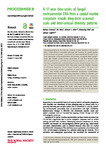A 17-year time-series of fungal environmental DNA from a coastal marine ecosystem reveals long-term seasonal-scale and inter-annual diversity patterns
| dc.contributor.author | Chrismas, N | |
| dc.contributor.author | Allen, R | |
| dc.contributor.author | Allen, MJ | |
| dc.contributor.author | Bird, K | |
| dc.contributor.author | Cunliffe, M | |
| dc.date.accessioned | 2023-02-20T13:24:05Z | |
| dc.date.available | 2023-02-20T13:24:05Z | |
| dc.date.issued | 2023-02-08 | |
| dc.identifier.issn | 0962-8452 | |
| dc.identifier.issn | 1471-2954 | |
| dc.identifier.other | ARTN 20222129 | |
| dc.identifier.uri | http://hdl.handle.net/10026.1/20475 | |
| dc.description.abstract |
<jats:p>Changing patterns in diversity are a feature of many habitats, with seasonality a major driver of ecosystem structure and function. In coastal marine plankton-based ecosystems, seasonality has been established through long-term time-series of bacterioplankton and protists. Alongside these groups, fungi also inhabit coastal marine ecosystems. If and how marine fungi show long-term intra- and inter-annual diversity patterns is unknown, preventing a comprehensive understanding of marine fungal ecology. Here, we use a 17-year environmental DNA time-series from the English Channel to determine long-term marine fungal diversity patterns. We show that fungal community structure progresses at seasonal and monthly scales and is only weakly related to environmental parameters. Communities restructured every 52-weeks suggesting long-term stability in diversity patterns. Some major marine fungal genera have clear inter-annual recurrence patterns, re-appearing in the annual cycle at the same period. Low relative abundance taxa that are likely non-marine show seasonal input to the coastal marine ecosystem suggesting land–sea exchange regularly takes place. Our results demonstrate long-term intra- and inter-annual marine fungal diversity patterns. We anticipate this study could form the basis for better understanding the ecology of marine fungi and how they fit in the structure and function of the wider coastal marine ecosystem.</jats:p> | |
| dc.format.extent | 20222129- | |
| dc.format.medium | Print-Electronic | |
| dc.language | en | |
| dc.language.iso | eng | |
| dc.publisher | The Royal Society | |
| dc.subject | marine fungi | |
| dc.subject | plankton | |
| dc.subject | seasonality | |
| dc.subject | marine ecosystem | |
| dc.title | A 17-year time-series of fungal environmental DNA from a coastal marine ecosystem reveals long-term seasonal-scale and inter-annual diversity patterns | |
| dc.type | journal-article | |
| dc.type | Article | |
| plymouth.author-url | https://www.ncbi.nlm.nih.gov/pubmed/36722076 | |
| plymouth.issue | 1992 | |
| plymouth.volume | 290 | |
| plymouth.publication-status | Published | |
| plymouth.journal | Proceedings of the Royal Society B: Biological Sciences | |
| dc.identifier.doi | 10.1098/rspb.2022.2129 | |
| plymouth.organisational-group | /Plymouth | |
| plymouth.organisational-group | /Plymouth/Faculty of Science and Engineering | |
| plymouth.organisational-group | /Plymouth/Faculty of Science and Engineering/School of Biological and Marine Sciences | |
| plymouth.organisational-group | /Plymouth/REF 2021 Researchers by UoA | |
| plymouth.organisational-group | /Plymouth/REF 2021 Researchers by UoA/UoA07 Earth Systems and Environmental Sciences | |
| plymouth.organisational-group | /Plymouth/Users by role | |
| plymouth.organisational-group | /Plymouth/Users by role/Academics | |
| dc.publisher.place | England | |
| dcterms.dateAccepted | 2023-01-09 | |
| dc.rights.embargodate | 2023-2-21 | |
| dc.identifier.eissn | 1471-2954 | |
| dc.rights.embargoperiod | Not known | |
| rioxxterms.versionofrecord | 10.1098/rspb.2022.2129 | |
| rioxxterms.licenseref.uri | http://www.rioxx.net/licenses/all-rights-reserved | |
| rioxxterms.type | Journal Article/Review |


